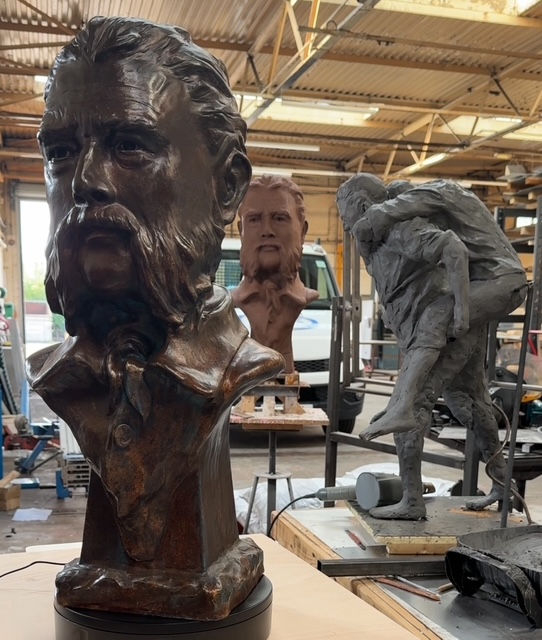Who Deserves a Statue?
- stansonart
- Sep 8
- 4 min read
Updated: Sep 9
Why public memorials reveal as much about the present as they do the past.

Walk through any British city and you’ll find yourself surrounded by statues — generals on horseback, civic benefactors, anonymous figures cast in bronze, fabricated in steel or carved in stone. They stand quietly in our squares and gardens, seemingly timeless, offering the illusion of permanence. Yet in recent years, these monuments have sparked as much controversy as admiration.
“The question of who deserves a statue has become less about bronze, steel and stone, and more about politics, history, and collective memory.”
The toppling of Edward Colston in Bristol in 2020 made international headlines. Some saw it as vandalism, others as long-overdue justice, but few would deny it was a moment that changed how we look at public memorials. Statues are no longer viewed simply as inert markers of history — they are living symbols, capable of uniting communities or dividing them.
So when we commission a new public artwork to honour an individual — whether living or long deceased — we need to ask: what are we really commemorating? And who is the commemoration for?
Living Subjects: Celebration or Canonisation?
Commemorating the living is a fraught business. The moment a community installs a statue of a contemporary figure, it effectively canonises them — sometimes before their life story has played out in full.
From an artistic standpoint, memorialising a living individual also creates a tension between representation and idealisation. Are we sculpting a likeness, or constructing a myth?
The Deceased: Who Chooses, Who Benefits?
Memorialising the dead is not straightforward either. Commissioners, whether councils, heritage bodies or community groups, are rarely neutral actors. Decisions about who deserves to be remembered, and how, reflect the priorities of the present as much as the past. Julie Crawshaw’s (2015) research on art and regeneration in Sunderland reminds us that public art is often entangled with civic planning and politics. At its best, this can be regenerative. At its worst, it risks tokenism. Having said that, as an artist I feel people's stories need to be told before they are forgotten. let me give a couple of examples from my own artworks. In the case of Molly situated outside the National Glass Centre in Sunderland on the site of the former shipyards where the likes of Molly worked. She is not representing an individual, she represents several hundred brave individuals who's stories had all but been lost. Her anonymity did not not the challenge the debate nor the commissioner's dilemma over memorialising an individual. Her inclusion in the Sunderland Sculpture Trail was welcomed and her image has become quite iconic, appearing in promotional videos of the area and featured in television programmes, sharing the story for the benefit of viewers, visitors and the local community.
In a current artwork (pictured below) I'm creating a sculpture of Joseph Ray Hodgson (1829-1908), a Sunderland hero famously known as "The Stormy Petrel" who saved over 40 lives from stormy seas, his bravery earned him numerous medals including a gold medal from Napoleon III for saving the lives of the crew of a shipwrecked French schooner in 1856.

Whilst his bravery was celebrated nationally as a Sunderland hero in the 1800's, his story too was at risk of being lost to history. However, because the sculpture depicts an individual the artwork may fail to comply with the contemporary criteria for public art display.
The Role of the Artist
As artists, we stand in the middle of these debates. Our task is not simply to fabricate in steel, bronze or stone, but to question the assumptions underpinning the commission itself.
In my own work, I’ve seen how community engagement can transform a memorial. The renaming of my sculpture Waiting for the School Bell to Joy by local residents was a reminder that once installed, an artwork takes on a life beyond its creator.
“The act of naming—or renaming—shifts the work from being a static object to a living part of a community’s story.”
Towards a More Reflexive Approach
Perhaps the challenge is to think of memorials less as fixed monuments and more as starting points for dialogue. The re-display of Colston’s statue in Bristol’s M-Shed — laid flat, covered in graffiti — is a striking example of how meaning can change over time.
This might mean building flexibility into commission briefs, prioritising collaboration with communities, or even embracing impermanence. After all, no sculpture is immune to the forces of history.
Conclusion
The debate around memorialising individuals in public art is not about whether we should remember, but about how. Each commission sits at the intersection of history, politics, aesthetics and lived community experience.
Bronze, steel and stone may endure, but meaning is never fixed.
Join the Conversation
I’d be interested to hear your thoughts: which statues in your own town or city spark pride, and which spark debate? Public art only truly comes alive through the conversations it inspires — so let’s keep the dialogue going.




Ronnie,
Thank you for a very thought provoking article in which you have raised some fascinating points concerning public and the portrayal of individual figures within this. There are a number of fascinating points this raises:
Art portraying individual figures.
As we see from the Colston statue. Societal
Impression and views of an individual can change radically over time. This is echoed in the USA with the continuing debates concerning statues of famous confederacy figures. I find that the art in these cases is almost taking on a living/dynamic role as a focal point for debate within the society they are positioned; in effect reenergising their role as a creative art form. I don’t see this as decisive and healthy…